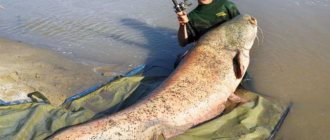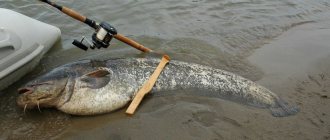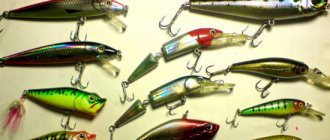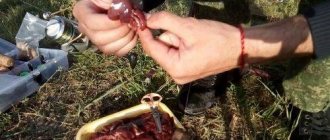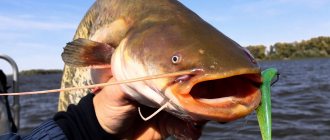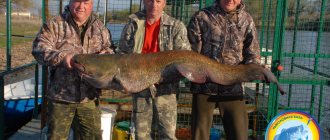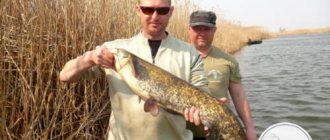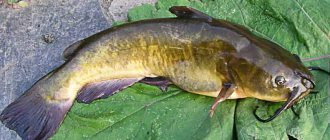Where to find catfish in the spring
When fishing for catfish in the spring, success largely depends on knowledge of the fish’s habitats. She begins activity near the hole in which she hibernated:
- In shallow, sun-warmed areas;
- Near trees that have fallen into the water;
- In areas with snags and overgrowth;
- On deep changes;
- In holes that begin on the shallows and enter the channel at the other end;
- On the edges of river channels and river fairways;
- Downstream beyond the locks and dams;
- In non-silted areas in clean, clear water.
To more accurately determine the location, you should stand in silence: if you hear periodic bursts and see a funnel characteristic of a catfish, be sure that you are at the target.
Where to look for catfish in May
In May, catfish leave their wintering pits and, in search of prey, spread throughout the entire water area of the reservoir. But this does not mean that you can catch a large predator in any convenient place. Although there are exceptions. Catfish weighing 1-3 kg can be bycatch during targeted fishing for crucian carp or pike. But such pleasant bycatch is an accident.
When choosing a place to catch catfish, you need to exclude areas of the reservoir where its appearance is unlikely. It avoids fast currents, rapids and does not enter shallow bays.
Signs of promising places:
- Entrances and exits from pits;
- Depth changes;
- Svali;
- Deep areas with the presence of bottom vegetation;
- The edges are away from the channel flow;
- The presence of flooded trees, bottom boulders, snags and artificial structures;
- Coastal areas with a large number of frogs. In shallow water they become prey for predators from dusk until dawn.
Catfish gear should be selected for specific fishing conditions.
Catching catfish in April
Catfish fishing in early spring begins in mid-April, provided that the water has already warmed up to 10 °C. To determine the temperature, it is not necessary to have a thermometer - water is 3-4 °C colder than the outside air.
At this time, you can fish with almost all baits, but only daytime fishing is effective, night fishing does not give results.
During this period, catfish are characterized by wariness, so they do not swim far from the holes; in rare cases, if the day turns out to be very warm, they are likely to be in the shallows.
Catfish spawning period, when the fish begin to bite
After hibernation, the catfish wakes up when the water temperature reaches +10°C. Depending on the vagaries of nature, the bite may begin at the beginning or end of April. At the beginning of spring, catfish do not move far from their winter camps.
Catching catfish in early spring is possible even at shallow depths. As the water warms up, the fish more often visit shallows and reaches, where they bask in the rays of the warm sun. On warm spring days you can catch catfish all day; fishing at night is not very promising. As the spawning period approaches, the fish's appetite increases and the bite improves.
Catfish spawn in May, when the water warms up to 18°C. Spawning lasts 2-3 weeks, after which the fish rests for some time. Then comes a strong and prolonged zhor. At this time, the angler can get real pleasure from catching catfish.
In April and May, the bite of this large fish is unstable. Catfish react sensitively to weather changes. Fishing in spring is carried out both from the shore and from a boat.
Habits of catfish in spring
The behavior of fish has seasonal differences. Her preferences are different in the spring months.
- April:
- Not very active at night;
- Lives near holes in which it hibernated and in deep places;
- It is hungry, so it will covet all baits, especially at the beginning of activity.
- First half of May:
- Comes out of holes and is visible in shallow waters;
- Pre-spawning zhor is characteristic;
- It hunts mainly at night, but is also active during the day.
- Second half of May:
- goes to spawn, but does not bite;
- After spawning it is passive.
Article on the topic: Catching catfish with kwok
Fishing methods
To catch catfish in the spring, powerful gear is used. You shouldn’t count on the fact that the fish has weakened after hibernation. Current methods of catching a “mustachioed” predator:
- for bottom tackle. For fishing from a boat in the current, this is the best option. The donkey rig is quite simple: a sinker is attached to the end of the fishing line. The mass of the latter is selected taking into account the characteristics of the current: on a weak flow, products of 40–50 g are used, on a strong one, up to 100 g. A pair of leashes with hooks are attached above. The latter should not touch the sinker. The fisherman, holding the fishing line tightly in his hands, can make minimal lifts of the equipment to attract the attention of the predator. What’s interesting: you can catch catfish using a “donka” both at the beginning of the bite from a boat and during the pre-spawning feast from the shore. That is, this is a universal tackle. To catch a “mustached” predator from the shore, a “donka” with a rod and a reel is used, or, in other words, a “throwaway”, especially if a thick braided cord is used;
- for spinning. This tackle is suitable for catching catfish only from the shore. The choice of rod should be made based on personal preferences regarding wiring technology. But in any case, the spinning rod must have strength characteristics. A rigid rod is chosen for the equipment, since heavy baits are used. Preference should be given to braided fishing line, since it is characterized by high strength and will ensure the sensitivity of the gear. It is better to choose a power coil. Fish are caught using spoons and jigs. A carp inertia-free model is suitable for casting heavy baits from the shore;
- on kwok. It is a device consisting of a handle, a snout and a leg, which, when struck on the surface of the water, produces a characteristic sound that attracts the attention of the fish. Catching catfish with a quok must be done from a boat. Since the plan is to hunt for a large animal, the gear chosen is quite powerful;
- on a wobbler or, in other words, on trolling. This method assumes the presence of a moving watercraft. The rods are attached very tightly to the boat, since the hunt is for a large trophy. On each tackle there is only one bait, which moves behind the boat. The predator will not chase the rapidly flying bait. The best result will be provided by a wobbler that will move at low speed and gradually cling to the bottom, creating additional noise. After all, catfish hear and feel the vibrations of water well. You can catch the predator by trolling from the beginning of April to the end of October.
To increase the fish catch, it is recommended to increase the sensitivity of the gear, use a bite activator and pheromone-based bait.
Catching catfish in the spring on a donk
It should be remembered that in spring this freshwater giant is passive at night, so daytime fishing is preferable.
Depending on the water temperature, there are three periods in its behavior.
- The beginning of biting on donka is 9-11°C;
- An improvement in the daytime bite is characteristic: 12 – 15°C;
- Spawning lull, no fishing 16-19°C.
The best bite for catfish in the spring is on a donka from a boat using a kwok (a device that, when in contact with water, creates a characteristic sound), causing fish to float up from the holes. Catching catfish in the spring on a donk from the shore is most effective with tackle and a rod. You can also achieve a good catch by replacing it with a reel, which is distinguished by its compactness. In this case, the optimal thickness of the fishing line is 0.7, and the leashes are 0.6 mm. Attach them 20-25 cm from each other after a sinker weighing at least 50 grams.
The spring catch will be most likely if you cast not one, but several bottoms; equipping the rod with small bells helps to track the bite.
Tackle
In spring, catfish are not nearly as active as in summer , so leisurely fishing methods, such as fishing with a donkey, are advantageous.
Donka with a reel
The simplest gear for catching catfish is a donka with a reel. It includes the following elements:
- Reel . The reel is used to store fishing line and is cut from wood, plywood or foam.
- Fishing line . For donk fishing, use thick monofilament or nylon cord.
- Sinker . The sinker must have enough weight to cast the desired distance and hold the equipment on the bottom in the current.
- Hook . Depending on the type of bait, a single or treble hook is used. Its size also depends on the size of catfish you intend to catch. The hook is tied either to the main line or to the leash.
Donka with a rod
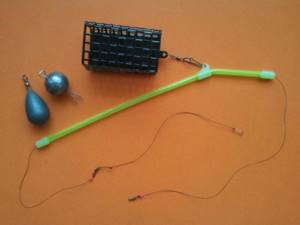
The rod and rod consists of the following elements:
- Rod . To catch catfish on a donk, a powerful fiberglass rod is used, the length of which depends on the fishing conditions, namely the casting distance, the height of the bank, etc.
- Reel _ To catch catfish on a donk, you can use an inertial or inertial-free reel and a multiplier. Everything is determined by the financial capabilities and personal preferences of the fisherman. In any case, the reel must be powerful and have a size (spool) necessary to store a significant supply of fishing line.
- Fishing line . For bottom fishing with a rod, you can use monofilament fishing line and braided cord. The final choice remains with the fisherman.
- Equipment . The equipment for fishing with a donkey with a rod is the same as for fishing with a donkey with a reel.
Spinning

Catching catfish in the spring with a spinning rod has certain prospects, although fishing with natural bait is definitely more effective. Spinning tackle for catching catfish includes the following elements:
- Rod .
A rod for catching catfish should belong to the heavy or extra-heavy class, i.e. his test should start at 30 grams, and his upper limit depends on what weight of bait is used and what size catfish can bite. A carbon fiber spinning rod is preferable, since a fiberglass rod with similar power will have prohibitive weight. The length of a spinning rod for shore fishing can reach 3 meters; for boat fishing, shorter rods are required. It is better to use a fast-action spinning rod, since it works well when fishing with both jig baits and spoons, and they are the main spinning baits for spring catfish hunting. - Reel _ The reel can be used inertia-free and multiplier. Regardless of what an angler chooses, the reel must be powerful, strong, and able to hold enough line or line.
- Fishing line . When fishing for catfish using a spinning rod, it is better to use a braided line that is thick enough to handle trophy fish.
- Leash . Although the catfish does not have sharp teeth, like a pike, when fishing for a long time, it is able to grind the braided cord with “brushes” made of small teeth located on its jaws. Therefore, it is necessary to use a metal leash, preferably a soft one.
Expert opinion
Knipovich Nikolai Mikhailovich
Zoologist, hydrobiologist. I am interested in fishing at a professional level.
In the spring, casting with a spinning rod is practiced, since catfish have neither the strength nor the mood to chase fast-swimming trolling baits.
Kwok
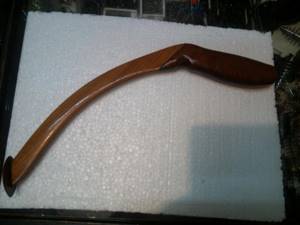
Fishing with quok often occurs in the summer, but during the pre-spawning period it can be very productive.
The kwok is a special device with which the fisherman forces the catfish to rise from the depths and grab the bait, since the kwok, when used correctly, makes certain sounds that attract the predator . The actual gear for fishing with kwok is a donka: simple or with a rod.
Next, we suggest watching an informative video about kwok fishing:
Fishing attachment
When starting fishing, you need to know what catfish bite on. He has a good sense of smell and sensitivity, so you should use bait with a scent, preferably a little spoiled and capable of moving.
The attachments are very varied:
- Available in fishing areas - frogs, small pike, pike perch, shell entrails, crayfish.
- Insects – mole crickets, locusts.
- Earthworms, caterpillars, leeches.
- Pieces of poultry, liver, fried brisket.
- Pork – sliced meat, liver.
- Mice.
- Artificial - vibrating tails, twisters, silicone worms, artificial mice, wobblers, etc.
Article on the topic: Catching catfish with a line
The baits must be large, determined based on the desired size of the catch, and must have a ratio with the handle, 1:4, 1:8. There is a direct relationship between the size of the catch and the size of the bait. If you put a small worm on each hook, ruffs and minnows will eat them. Remember how a catfish bites - sharply, without pauses, pulling to the bottom.
Differences in fishing techniques in still waters, rivers and flowing lakes
Catfish are almost never found in closed standing reservoirs, but they live in flowing lakes. The features of catching catfish in standing reservoirs are the following :
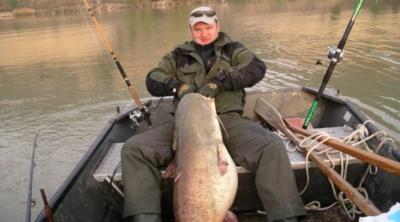
- In the absence of a current, heavy sinkers and baits are not required, so the gear can be lightweight, and in addition, it is much easier to catch a predator in still water.
- Natural baits must have greater mobility so that the catfish can notice them. Therefore, when fishing in still water, frogs and live bait are more often used.
Accordingly, when catching catfish in early or late spring on a river, the gear should be more powerful , the loads should have a streamlined shape, and the fishing line or cord should have a small diameter (to reduce windage), but a high breaking load.
Features of catching catfish with bottom tackle
Bottom tackle is a combination of fishing line (cord) with a sinker and leashes with hooks. The peculiarities of fishing with the help of such a device are that it is done without the use of a fishing rod and is carried out mainly on boats. The tackle is held directly in the hand and equipped with a sinker weighing from 30 grams and a powerful hook. In addition, it is advisable to have two fishermen in the boat, since the method is not safe and requires caution, especially when catching a large specimen.
According to fishermen, fishing with bottom gear is the most convenient fishing technique.
Baits and lures for catfish in spring
When catching catfish in the spring, various artificial baits and natural baits are used. For bottom fishing, the simplest and most accessible bait is an earthworm . You can buy it or dig it yourself. A bunch of worms are attached to the hook; most often catfish weighing up to 1 kg will be caught.
The closest relatives of worms are crawlers. You can also collect them at night in a park area, armed with a flashlight.
The shallower the depth, the smaller the bait should be. It is recommended to increase its size only if there is no bite.
Crawlers are an excellent bait for catfish in the spring.
Loves catfish and various insects. The most suitable insects would be mole crickets and locusts. The main problem for the angler is finding these baits. After winter, you need to look for mole crickets with a shovel under heaps of manure left in the fall. If you can find a nest, then several large insects are guaranteed.
Locusts can only be used in the southern regions, where they eat farmland. Insects are pinned on the hook, 3-4 pieces each.
If there are a lot of shellfish in a river or reservoir , then it is better to catch catfish using a shell or mussel. First you need to open the shell and take out the soft body. It is put on the hook in any way.
In the spring, live bait becomes an effective bait , with which you can catch a large mustachioed predator. A variety of live bait can be either a crayfish or a frog. The last bait is good because it is widespread.
oscillating spoons are best suited for spring fishing The mistake many anglers make is not having these lures in their arsenal. The thing is that the spinner allows the spinner to guide it in different layers of water. A wide and light spoon is perfect for fishing in shallow waters, while narrow and heavy models can be used to “tap” the bottom with a jig.
baits will also be a formidable weapon when fishing in pools and deep holes . First of all, these are twisters and vibrotails equipped with heavy jig heads. For fishing, classic stepped fishing is used.
How to catch catfish on a donk from the shore (2 options and fishing technique)
- Fishing technique using coastal bottom tackle with a rod during the pre-spawning period.
Catching catfish using this technique gives good results in the spring , especially in May, during the pre-spawning period, when the water temperature in the reservoir is at least +16°C.
- Determine the location. During this period, this is easy to do, since the catfish actively moves in shallow waters.
- Place the rod on a strong support and tie it to a stake driven into the ground.
- Loosen the reel clutch to avoid line breakage in case of a possible jerk.
- Provide your gear with an audible bite indicator in the form of a bell or an electronic alarm.
- Use enzyme-based baits or a feeder with a combined animal and plant composition in a ratio of 70% to 30%.
- Wait for the bite; as soon as it happens, hook it immediately.
- Start fishing.
- Classic fishing technique without a rod.
Article on the topic: Do-it-yourself quack for catfish
This technique is very effective when catching large specimens and consists of the following steps.
- In warm, pre-storm cloudy weather, secure several classic donks on the shore using carved homemade spears stuck in the sand. Rogatins, with this technique, also perform the function of a reel.
- Make the tackle from a greenish cord and provide it with a float to control the bait.
- Secure the butt of the tackle with a carabiner to the tree trunk
- Thread the bait in a bunch. You should have several different baits in your arsenal.
- Throw the tackle and pull towards you until the slack in the cord is eliminated and a depth of 2 meters is reached.
- After casting, attach any available bite alarm.
- Put on gloves and, having noticed a bite, start pulling out - if the fish suddenly moves away, lower the line a little and then hold it, trying to reduce resistance and fatigue.
- Drag the catch closer to the shore and take it into the landing net.
- A large specimen should be taken under the gills with a hook and stunned.
The table shows the equipment for both techniques.
| Type of fishing line | Main line, mm | Leash, mm | Leash length, cm | Type of sinker | Load, g | Hooks, no./piece | |
| I | monofilament | 0,5-1 | 0,4-0,8 | 100-150 | Standard, sliding | 100-150 | 10-40/ 2,3 |
| Wicker | 0,5-0,8 | ||||||
| II | Twisted cord | 0,7 | 0,6 | Deaf | At least 50 | 10-40/1 |
Choosing a fishing spot
Catfish belongs to the category of predators that feed on carrion and other baits of animal origin. Its head makes up 1/6 of its body, and such a giant can weigh 50 kg or more. This is a big trophy for fishermen.
Interesting fact: catfish meat is not only very juicy, but also practically boneless
Throughout the winter, the fish hibernate in wintering pits. And only when the water warms up well (its temperature should be approximately +10 degrees Celsius) does the predator wake up. That is, fish activity especially increases with warming.
In the life of catfish in spring there are two periods:
- start of activity;
- zhor before spawning.
When does the catfish start biting? Early spring is usually characterized by dry weather with little precipitation. After waking up from hibernation, the predator is very hungry and begins to actively search for food. It is difficult to say exactly when fishing begins, as it depends on the weather. For example, in April the air temperature can reach 28–30 degrees Celsius, but sometimes there are frosts at night. Therefore, catching catfish in early spring has its own peculiarity. During the day, the “mustached” predator bites well, but at night there is no point in going fishing. To catch large prey, you should look for places with great depth. Therefore, fishing from a boat is considered ideal for this period. There are few bites at this time, it is almost impossible to catch a record amount of prey. Fishing from a boat in Astrakhan is allowed only until April 20. From now on, due to the beginning of spring spawning, according to the legislation of the Russian Federation, fishing on the river is possible, but from the shore.
Video: Catching catfish on Akhtuba with a jig
At the beginning of May, the catfish begins to actively search for food. The water temperature at the beginning of the month ranges from +12 to +15 degrees Celsius. During this period, the fish have already fully “encouraged”, so the catfish begin to actively move around the reservoir. They have a pre-spawning glutton. Moreover, even in shallow water, in the coastal zone, you can find small specimens, since decent food reserves are concentrated in such areas. But large trophies like to stay on stretches, where there is a weak current. When do catfish bite in May? It is better to hunt the “master of the rivers” closer to the night, mainly at sunset.
See also:
- How to catch pike perch in winter
- Fishing rod for catching bream from ice in winter
- How to equip a fishing rod for winter roach fishing
Interesting fact: with each warming, the fish need more and more food
When the water warms up to +19 degrees Celsius, the fish go to spawn. At this time, the “mustached” predator is not biting. The spawning of mature catfish eggs usually occurs in mid-May and lasts up to about two weeks. And again, it all depends on the temperature indicator. After the process of mating and fertilization, the predator rests, and then it experiences a post-spawning glutton.
Where can you find catfish in the spring? This fish loves to swim and feed in clean waters, so you should not look for it in areas of the reservoir with a very muddy bottom.
Promising places for catching catfish:
- deep river holes;
- channel edges;
- snag
Catching catfish with an echo sounder is a practical solution. This device allows you to quickly and correctly determine the bottom topography.
Fishing for catfish
It is considered the most difficult process, requiring caution and patience. Step-by-step instruction:
- Wear thick, durable gloves to protect against injury.
- Make the fish tired by gently shaking it from side to side without loosening the line.
- If the fish lies on the bottom, tap the rod, getting scared, it will certainly float up.
- Having noticed the fish turning belly up, start dragging it to the shore.
- Hook the hook onto the gills and pull it out of the water.
Knowledge of such simple subtleties will certainly bear fruit and have a positive impact on the results of fishing; you will be able to make the dream of any fisherman come true - to catch a large catfish, which will become a source of pride for you.
